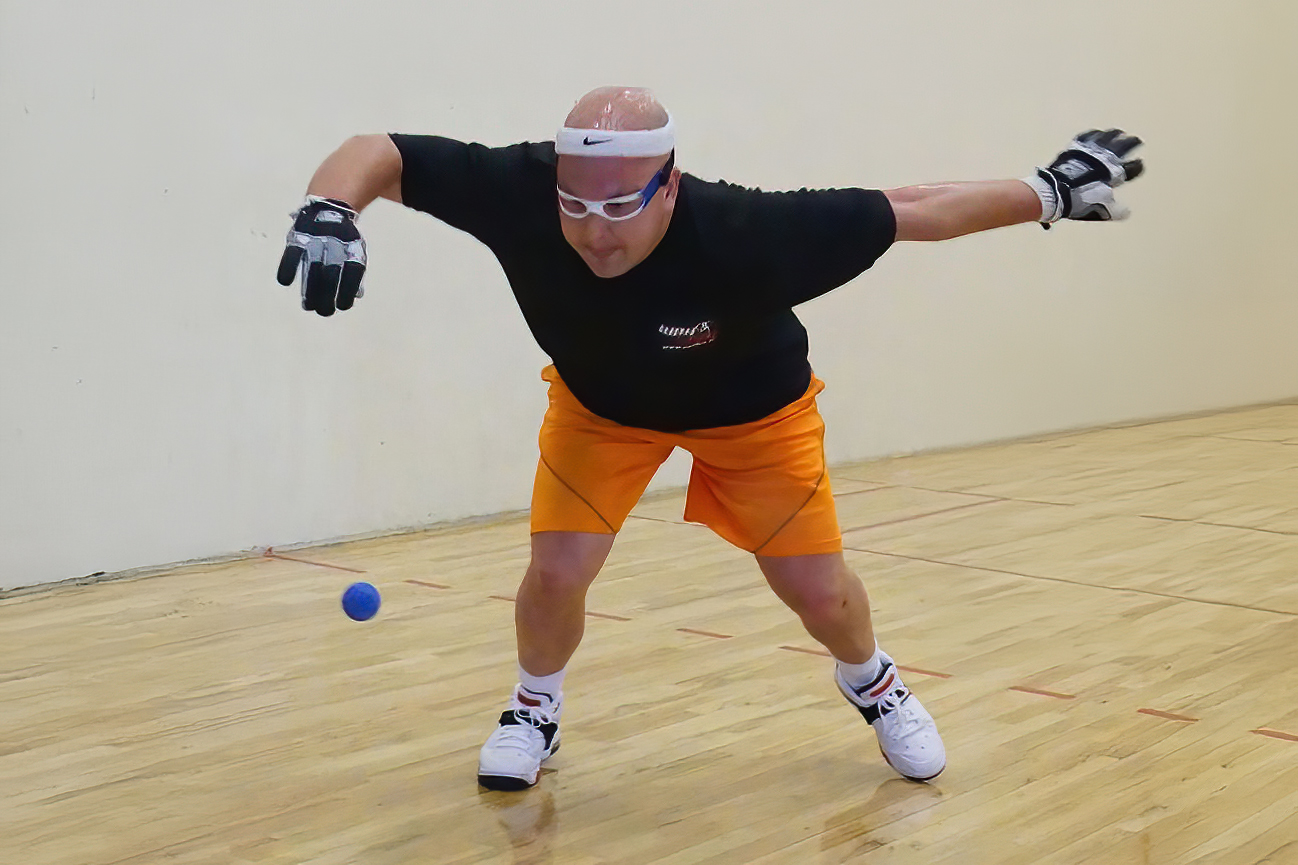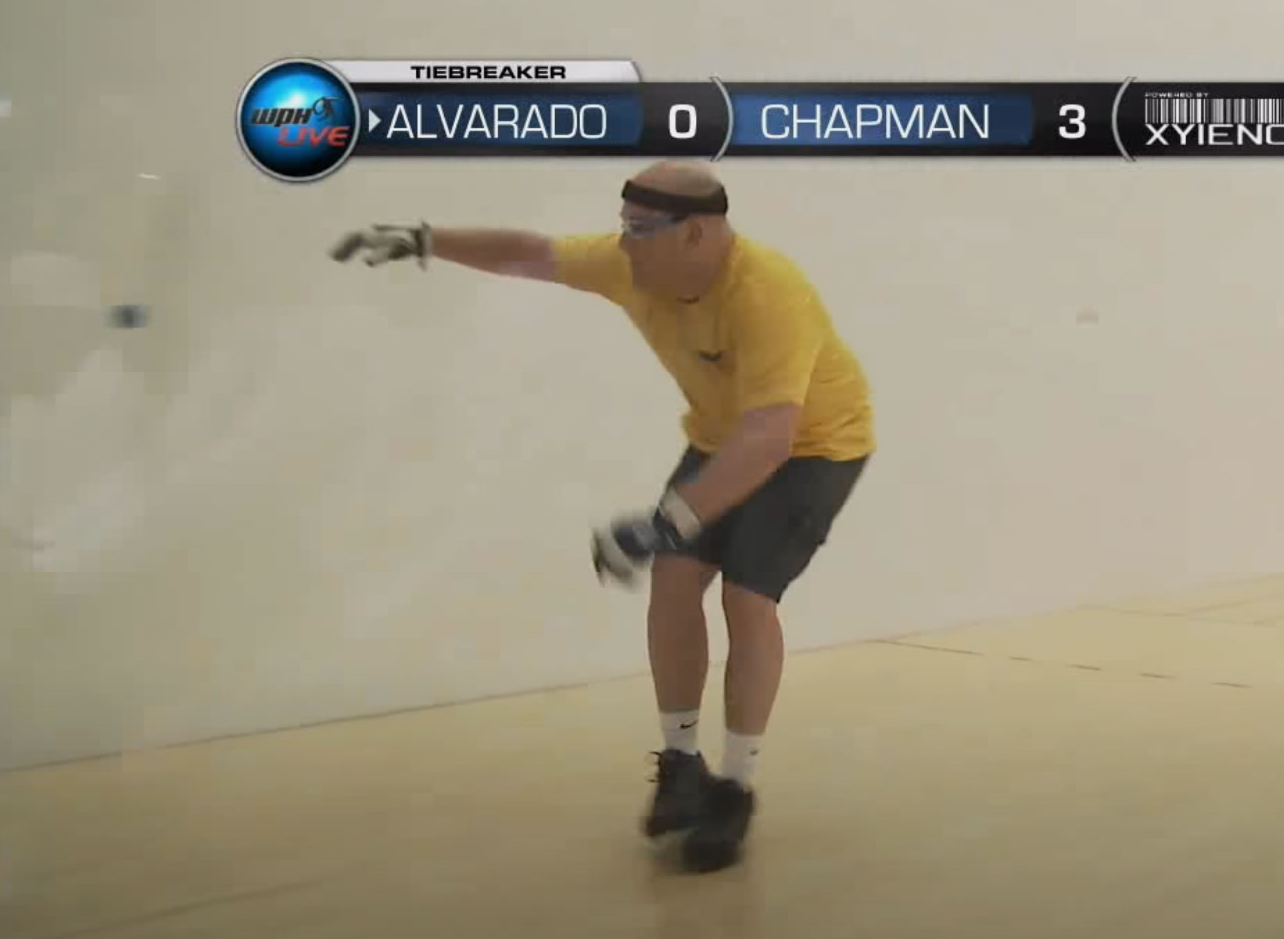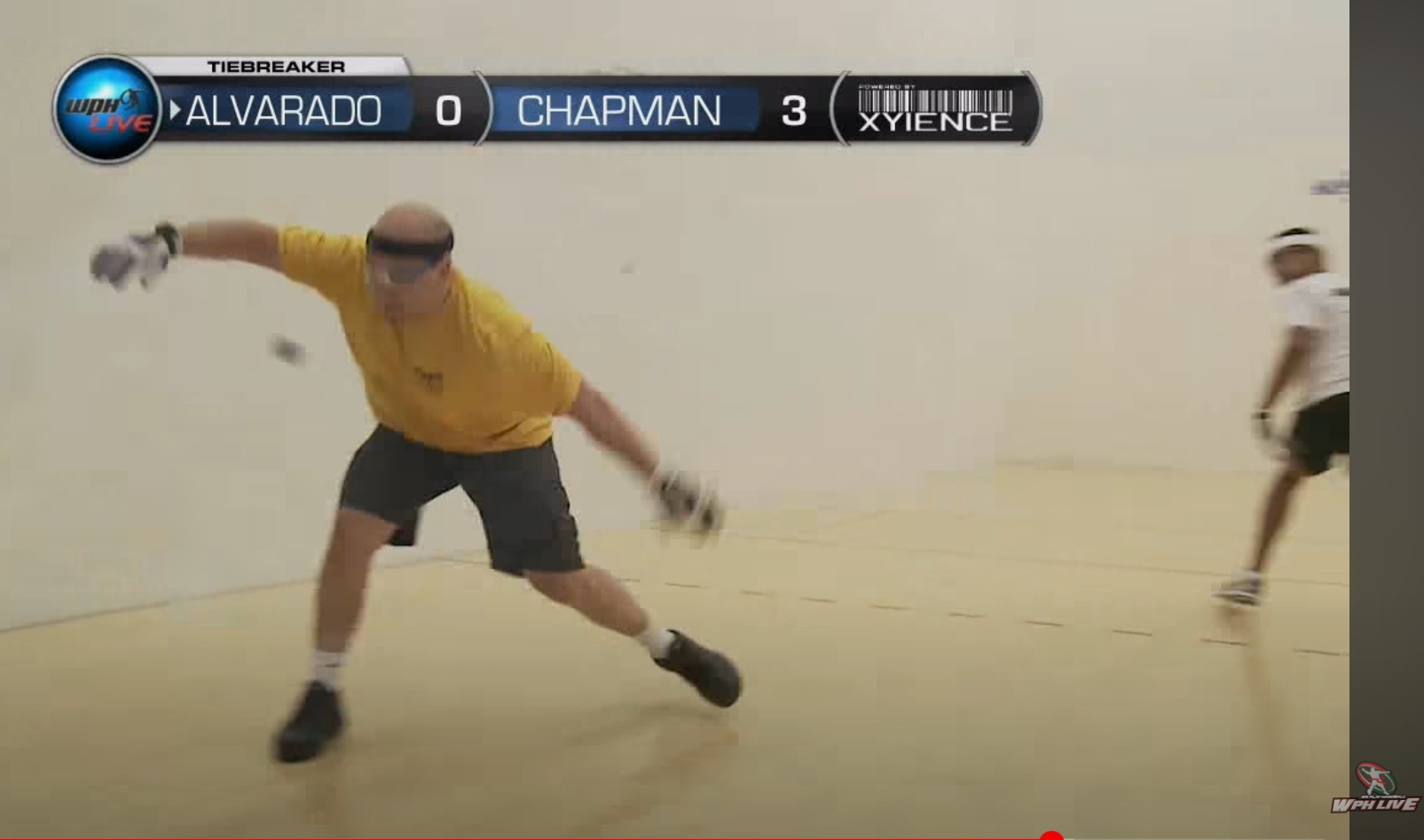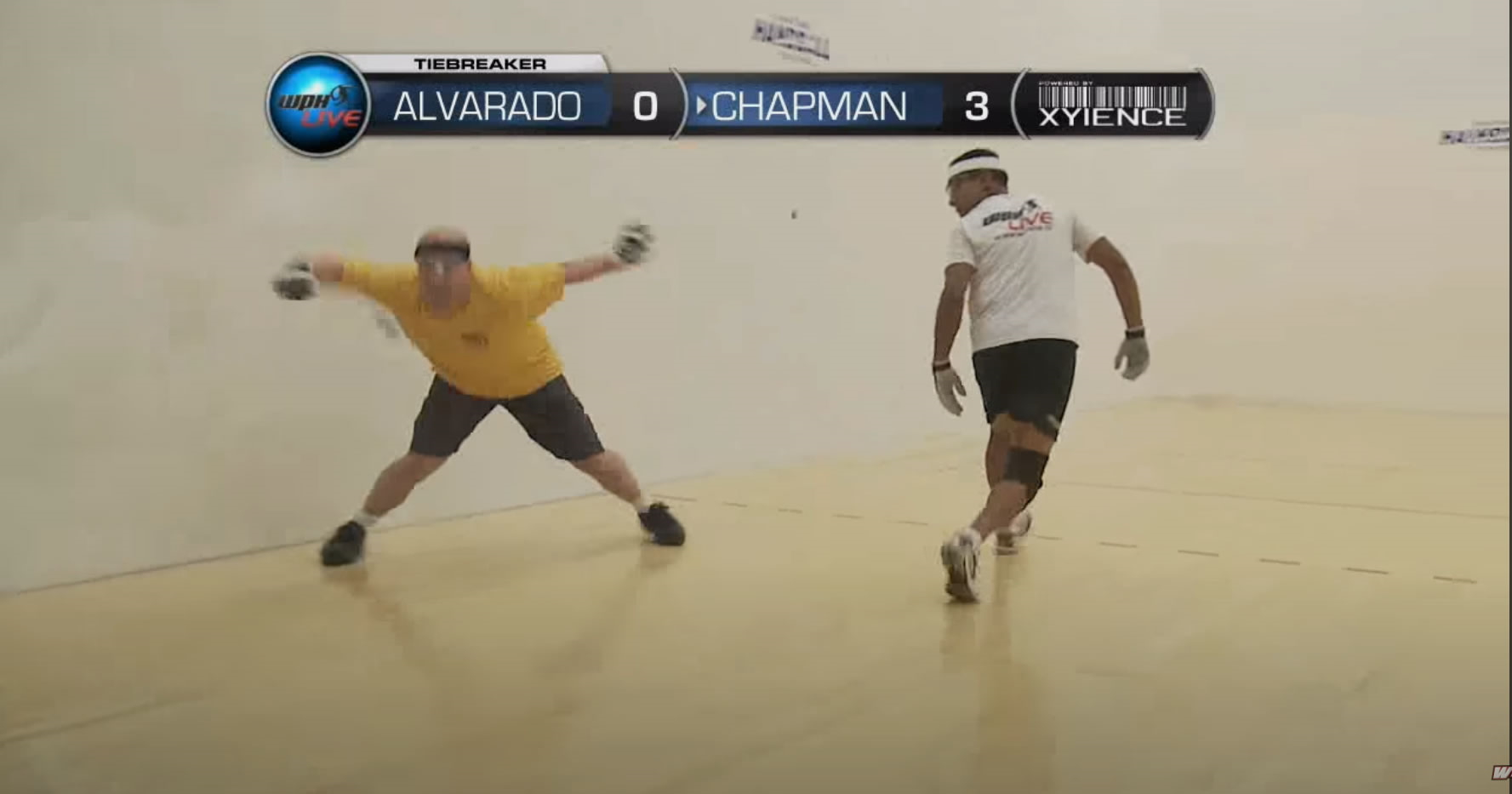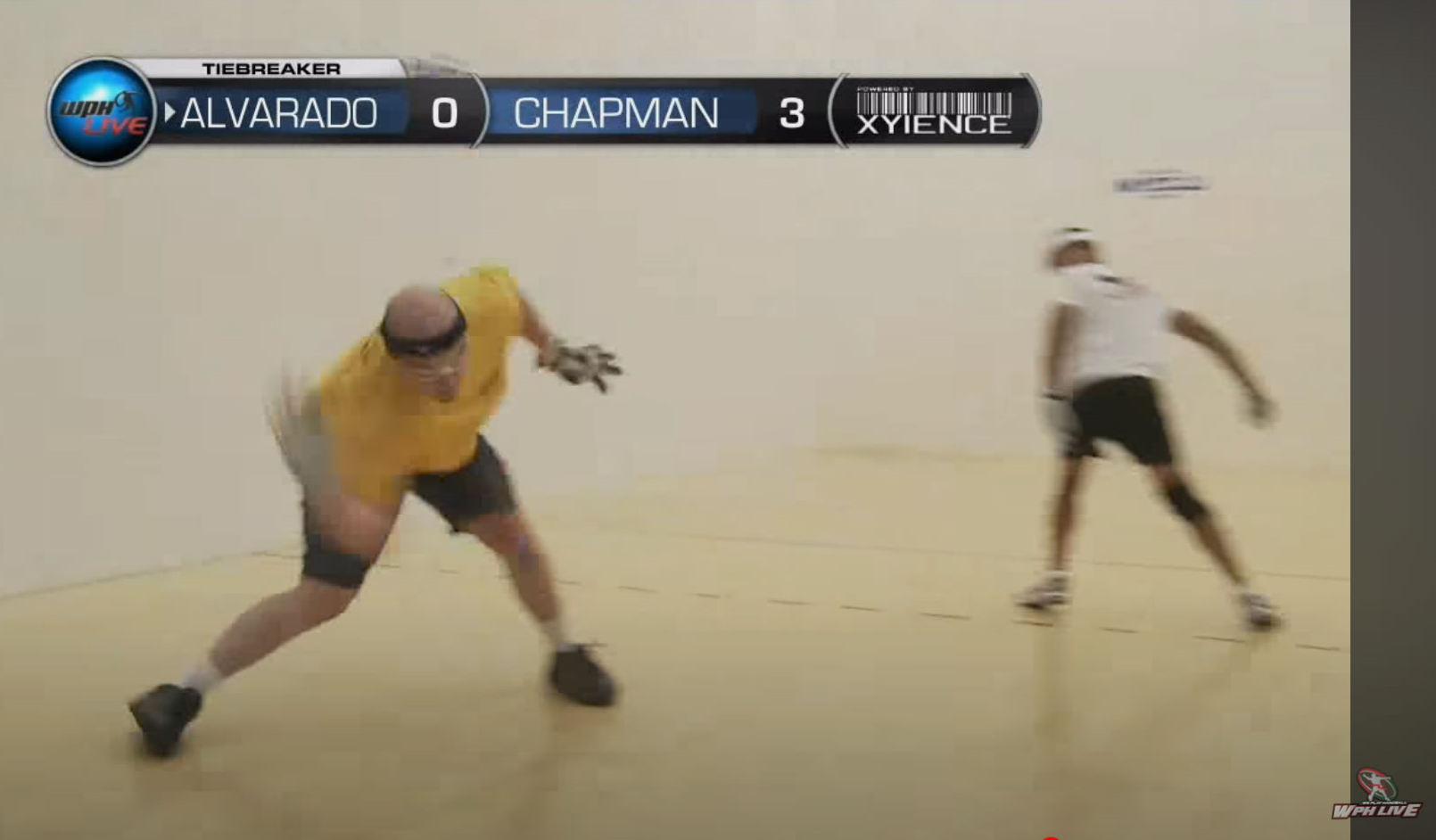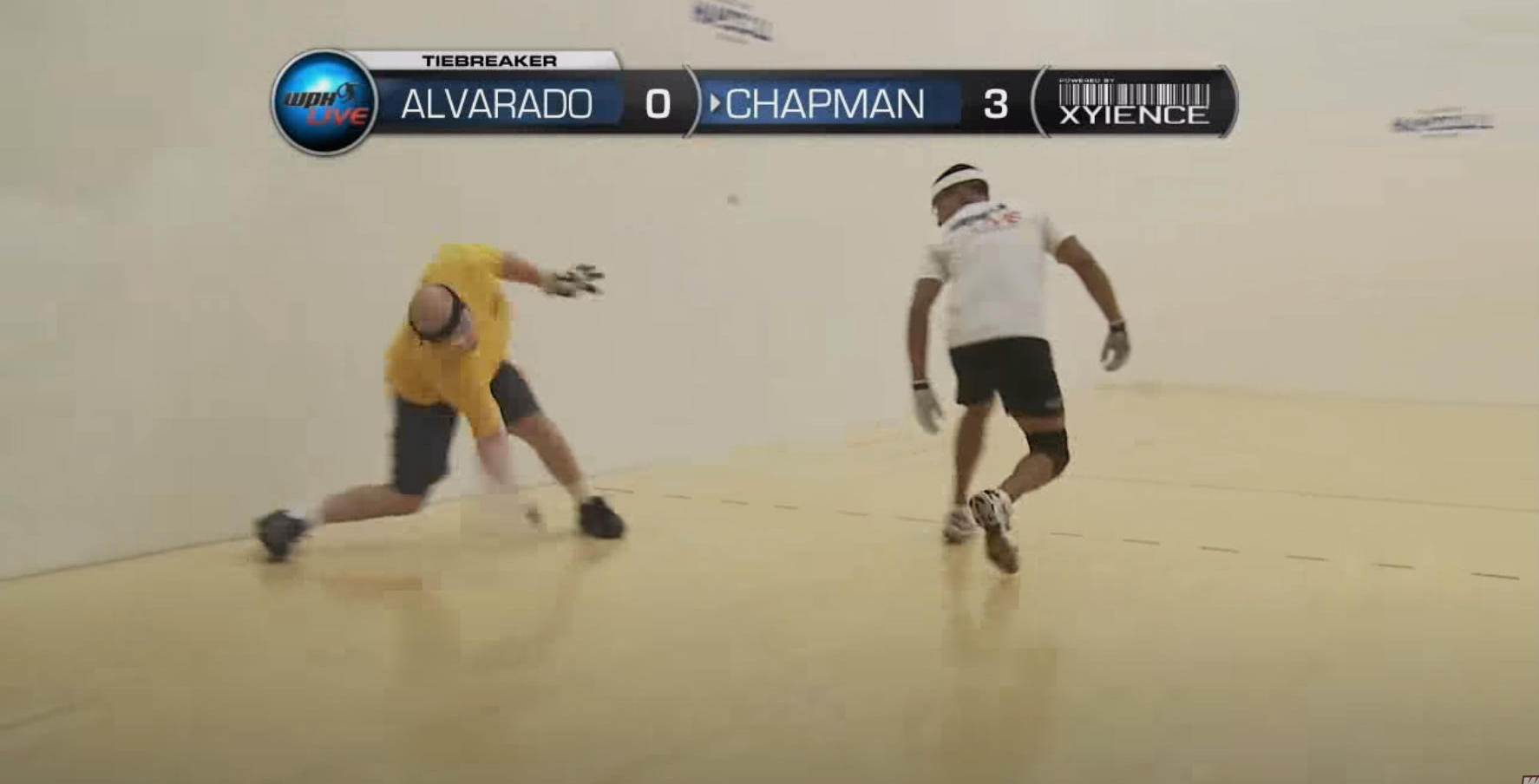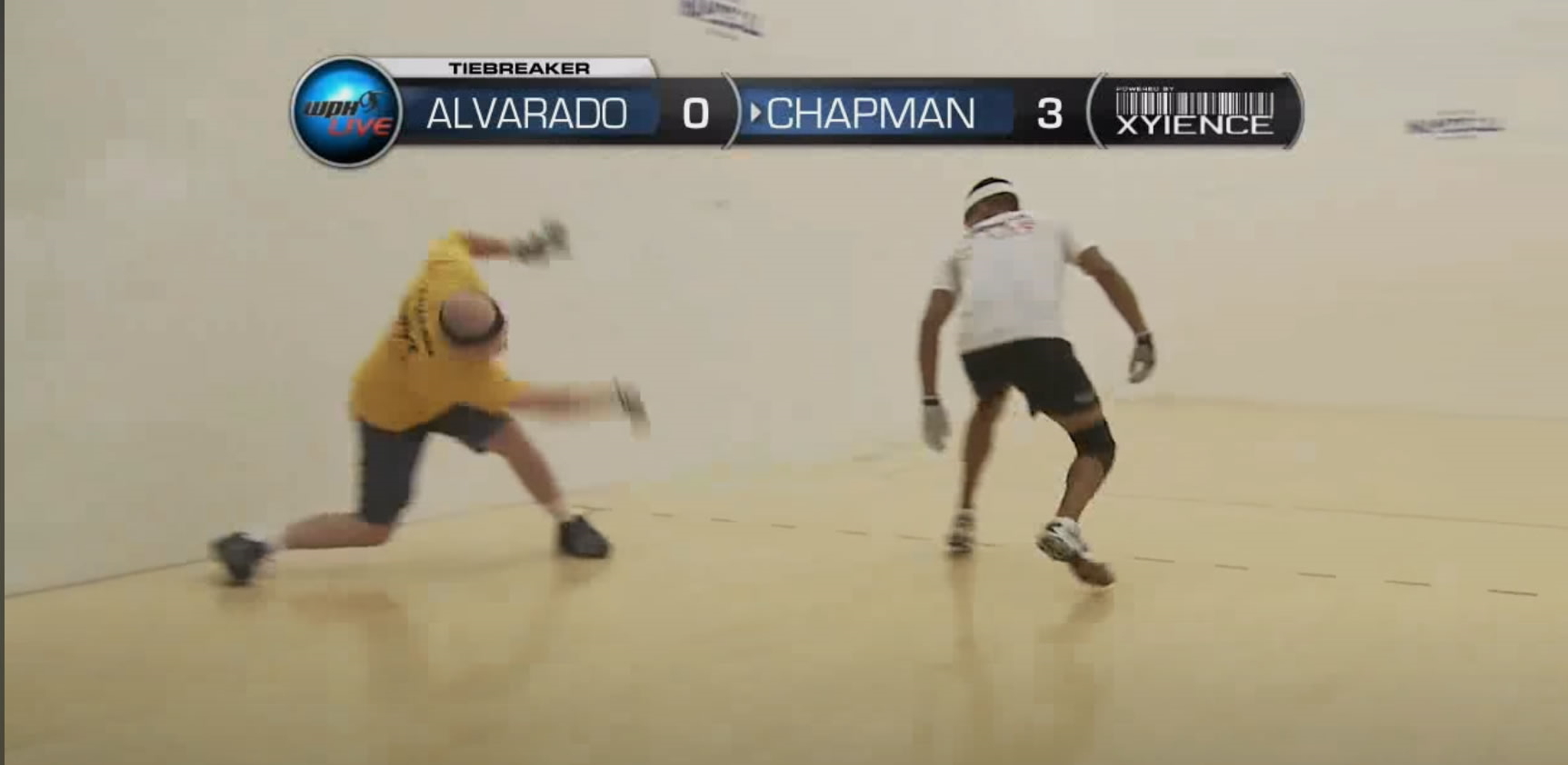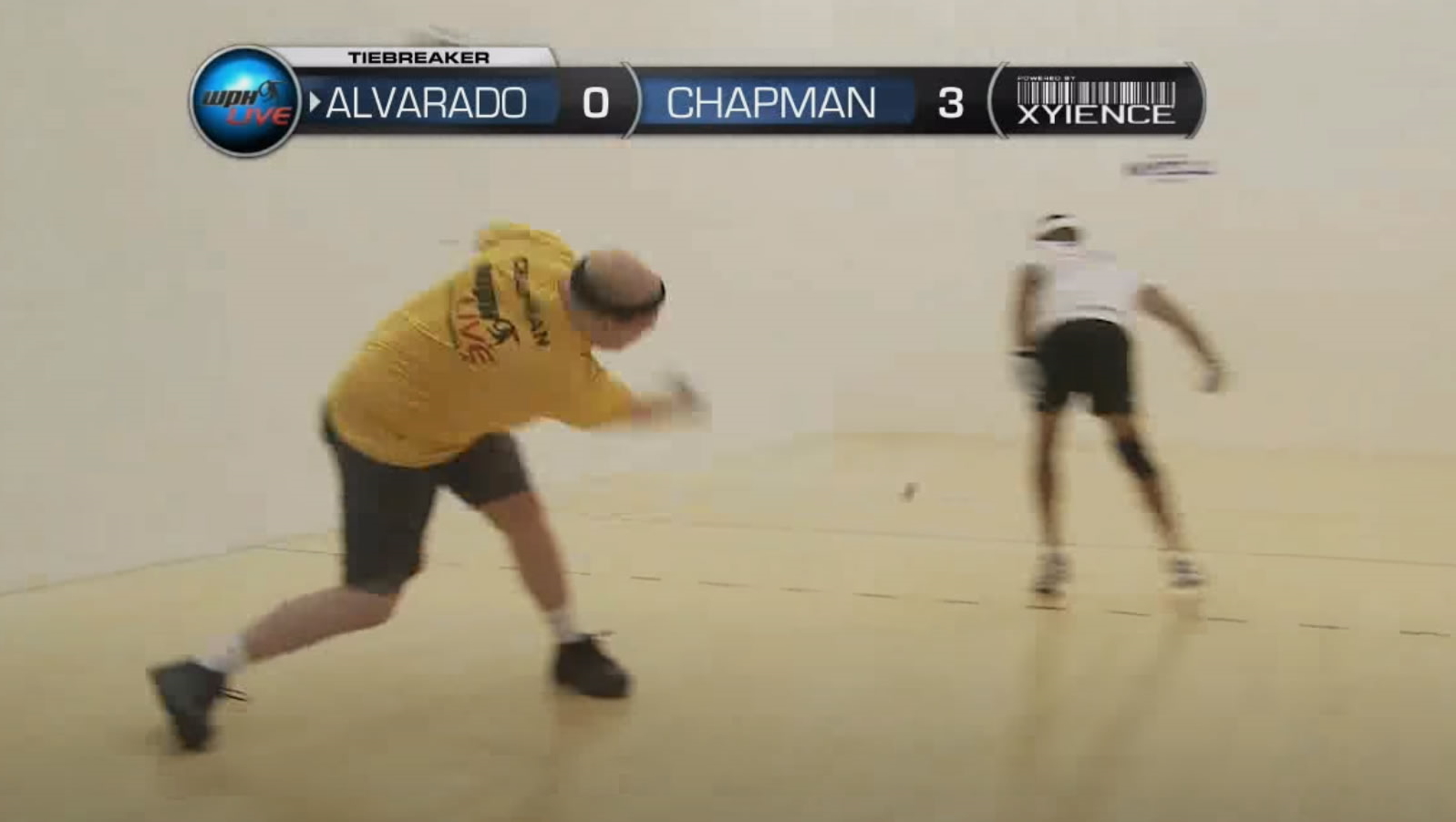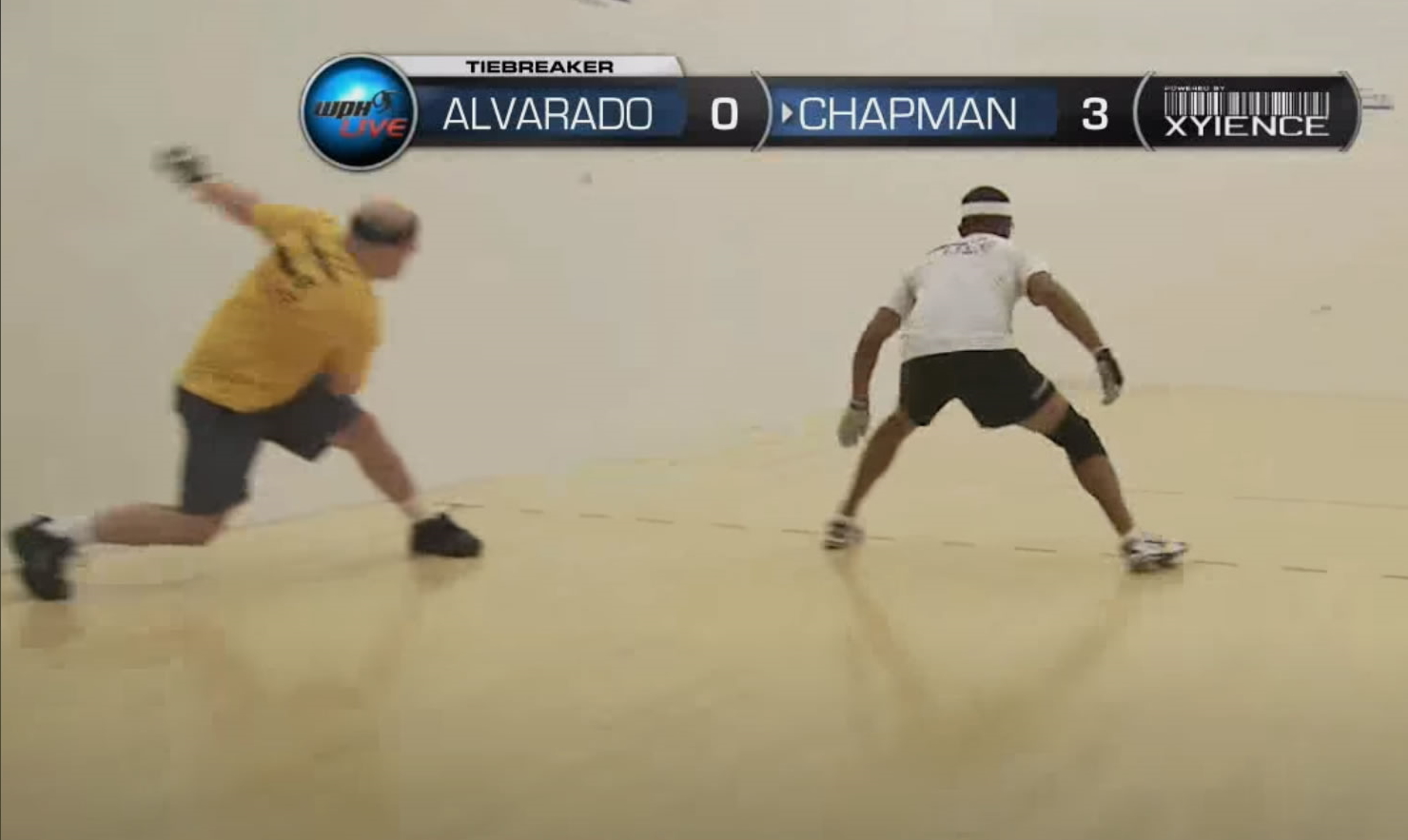WPH Coaching Center: ON TGO’S NONPAREIL BACKWALL SHOT: A 100 % TWO-WAY SHOT
By Boak Ferris, WPH Certified Coach
Indisputably, David Chapman had the best backwall shot ever in handball.
While he was not particularly flexible, and while he sometimes competed at a heavier weight than he would have preferred, he could contact the ball at floor-height when he wanted to dismantle his opponents with his highly evolved 100 %, two-way, scoring shot. All of his serves—and all of his shots—during rallies, he directed with one goal in mind: to force the opponent to overhit the ball, which all of his opponents did.
He referred to the best opportunities in handball as 100 % shots, which he also called two-way shots—and during webcasts, you can hear him admire competitors who achieve their 100 %, two-way-shot opportunities. There are simply too-few handball videos where he joined Dave Vincent, David Fink, or others in the announcer’s booth, and shared his wisdom.
Vincent and Fink both know what he meant, but sometimes handballers ask me, “What did TGO mean by a 100 % shot?” I report to them his answer, after I asked him years ago, “Why is any shot a 100 % shot?” His answer, “You can do anything you want with the ball, and you have more than one option. You know where your opponent is headed, so you will choose to hit the option that must score.” His classic 100 % shots included the paddle-shot, where he could go straight-in, clip the sidewall, go into the opposite corner, or change to a punch last-second, and drive a pass. (In essence, his paddle-shots were more like four-way shots, but the principle is the same.) He could also control center court with two-way punch shots, driving bounce passes, or hitting the roof, or punching into the corners. Against good V-passes, he usually punched these to the roof, or took them near the bounce and drove them low up the line, for a surprise finish. Despite ownership of all these shots, his notorious big weapon was converting backwall setups ad opportunities.
With those in mind, and after having received emails asking me to offer videos or photos instead of words, may I offer a short screenshot-sequence of TGO addressing the backwall shot, so readers can imprint the key stages of TGO’s biomechanical cycle?
In image one, TGO’s backswing levels his hitting arm with the ball, and also stays parallel to the floor. TGO will “suspend” or lag the hitting arm in that shape, while moving his feet and front arm, and while keeping his head still without making it stiff at the neck. His back foot, at the same time, finds its best place to plant. Here he combines a hybrid glide-step with a straddle-step, into the ball. The front arm torques, elbow pointing along the line of his knees. His eyes are glued exactly on the ball, because he intends to contact only a specific part of it.
In image two, TGO maintains that suspended, shaped, elevated, parallel hitting arm, while planting his rear foot solidly, with his torso-weight “inside” and over his rear quads. He has “hinged his rear hip,” while mildly bending his back leg, giving him counter-balance, in order to better lift his front leg and foot. He is already driving his front arm down with his front foot step, to leverage more front-arm torque, and to open his shoulders and accelerate his eventual torso turn. What’s easy to overlook is how he has made perfect space between the ball and his nose, eyes frozen to the ball, with a steady head, and he’s aligned his preparatory address of the ball with his back knee. He knew he wanted to align his rear knee behind the ball, which was one of his secrets for insuring consistently good contact on all of his shots.
In image 3, he has fully opened his shoulders prior to swinging down, while planting the ball of his front foot onto the floor. His feet are the same width apart as are his hands, allowing extraordinary balance. He has not shifted his weight, but his arms’ planes are parallel to the floor, with his bending hitting elbow pointing to the left “sidewall,” his front elbow pointing up, in advance of turning the front arm over, to generate the torque required. His rear-to-front toes-line points to the right front corner, but he is not aiming there. He doesn’t mind if his opponent thinks he’s aiming there. As with all good right-handed shots, TGO knew you had to step toward the right-sidewall, even if you park your behind on the left sidewall. He starts a sidearm swing, here, but he will finish pendulum.
In image 4, observant readers will notice that these screengrabs are not from the same single backwall shot; and that’s a point. He was always consistent on his backwalls, when he wasn’t injured. Here we see him driving his hitting elbow down behind the ball, his hand wide open. The front arm is starting to turn over, as is his back foot. A completed back-foot turn will release his torso and rear-quad turn into the ball; while the front arm “rectification” will release the stored torque and energy in his hitting arm to generate speed. His hitting shoulder remains very elastic, and his hitting arm is quite loose, but it retains a “deliberate shape.” By contrast, his front arm has much more apparent tension, which is because it is “holding the torque” required for his shoulders acceleration and rotation. His rear knee points at the ball. His rear-foot turnover is kind of unique, as, unlike most players, he will not turn the foot over up onto the rear toe, but rather, he turns the rear foot over such that his rear shoe’s inner sole almost entirely contacts the floor. It’s important to notice in this screenshot, that he has begun to “post,” a term meaning to complete the torso turn behind and inside the front quads, as the front leg pushes back against the forward momentum of his front step. Planting that front foot step solidly, and finishing the weight transfer about 2/3 into the inside of the front thigh, is crucial in achieving the catapulting power Chapman could generate. Also notice that the center line of his face points right at the back of the ball, with a perfectly steady head. He has identified which part of the ball he wants to contact with his hand.
An amazing moment, as so much good is here, is this fifth screenshot all you need? His rear foot has turned his rear hip and rear quads into the strike. His head and hitting arm are on a line behind the ball at contact. He has tilted his head so he can maintain his focus on his selected spot on the back of the ball. His shoulders are almost perpendicular to the floor, at contact. He is not hitting sidearm, but rather pendulum, as he did on “all” of his backwalls. He discovered that a pendulum-finish was superior to sidearm at keeping the ball down. Instead of imparting sidearm-sidespin, you use topspin, while being able to finish around the outside or the inside of the ball at contact. His hitting elbow is inside and in front of his back knee, on a line with his navel. His posting is perfect, as he pushes into and back from the front quads, while he also contacts the ball inside those front quads, about 8 inches behind the big toe of his front foot. He will contact the ball on a line running from his back knee—while his hitting arm is almost, but not quite, completely unfolded. He will suspend or lag a bit of hitting elbow-bend so he can add releasing it into the follow-through. His toe-line still points to the right corner. This toe-line suggests an obvious shot up the right, while allowing him to pull the ball to the left.
In image six, you can see that he has stayed down during his follow-through, and, like a master golfer, his eyes are frozen on the spot where his ball was. Without such elite eye-discipline, you will scatter the ball every time. He had the surest hands in handball, because he knew how to hold his eyes on the contact-target on the ball. He has held the ball in his hand from the contact he makes in image five, lifted up on the back of the ball, and then continued his palm and fingers around the outside of the ball to impart a low reverse. His deliberate and parallel-to-the-floor extension of his hitting arm, as also seen in image seven, will maintain the ball along the floor-line he previsualized before hitting. You should always previsualize your shots, before contact, for consistency. The wall isn’t going anywhere. He knows Naty Jr. has superior position here, but TGO’s elite biomechanics, combined with his intended 100 %, two-way options, will not be defensible. By the way, peripherally, TGO has already noted which foot Naty is on, and which foot is still in the air. Naty is making a split step, intending to take off to the right, following David’s toes-line. TGO has already shown mastery of the backwall kill-pass up the right many times, so Naty has to be prepared to chase to the right.
In image seven, TGO maintains the post, with his torso behind his front quads, rear foot turned over onto the insole. The front quads do a lot of work on the best backwall shot ever seen. While this screenshot is from a different backwall shot than in image six, you can see the consistency by continuing on to image 8. Naty has yet to place his right foot down, so in essence, TGO has wrong-footed him, because Naty will need to shift his weight back to the left to chase the backwall kill, and he will either be late and not retrieve it, or he will have to stutter-step to get behind it and fight it off, without the time to swing his right front foot around toward the left wall. Meanwhile, TGO intended to end up right behind Naty’s possible retrieve, and will have full view of whatever Naty tries to do. Naty is not going to hit a punch, or a ceiling, so TGO is prepared to retrieve a Naty rekill attempt, or block a Naty-pass up the left, or short-hop a Naty-pass headed up the right. TGO is in full control of 4 dimensions after his backwall.
TGO is rising up, from behind the post, to glide toward Naty’s current position. His left arm has continued moving way out to the side, to maintain acceleration through the shot, but also to help him keep his balance, and help pull him up, as the last part of any shot includes a return to center. If necessary, he will place one foot down on, or just behind, the dotted line, just as Naty hits. Now, in this image, did TGO shoot left or right?
Well, it’s a 100 %, two-way shot!
Wishing you good drilling!










